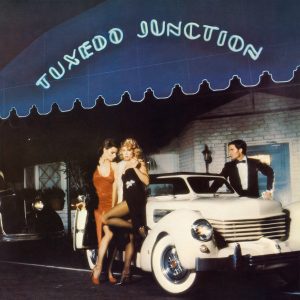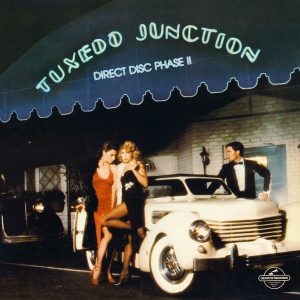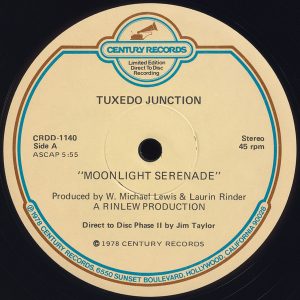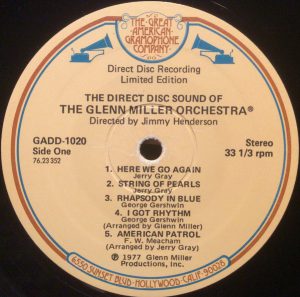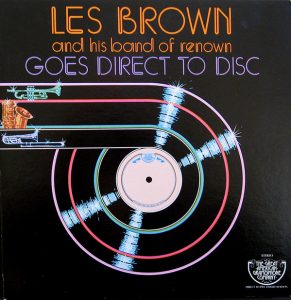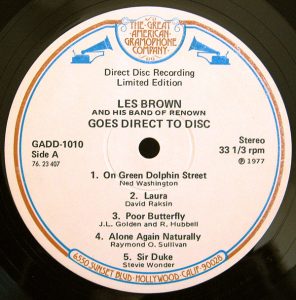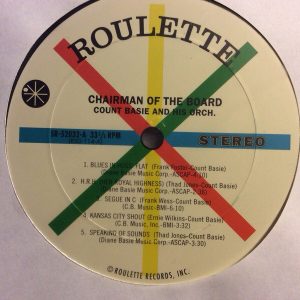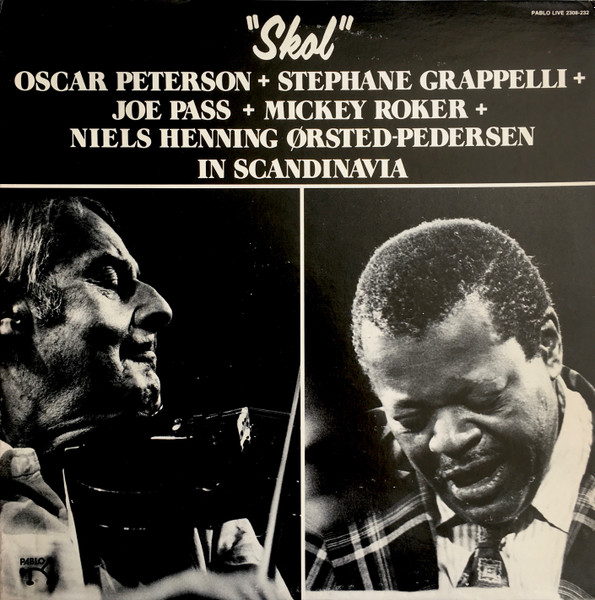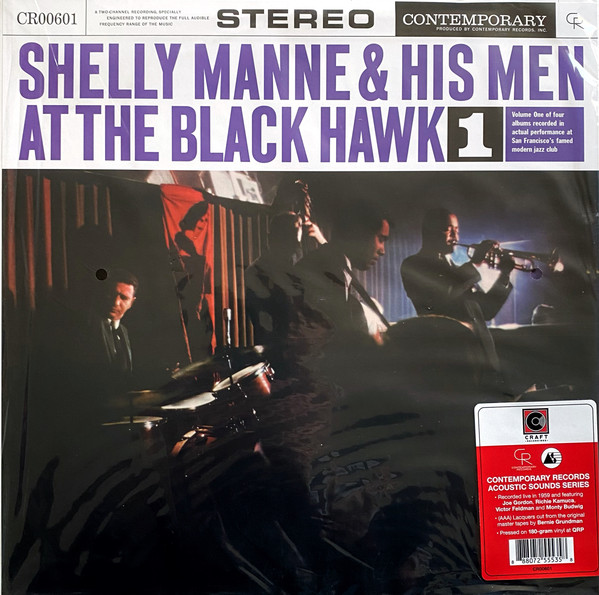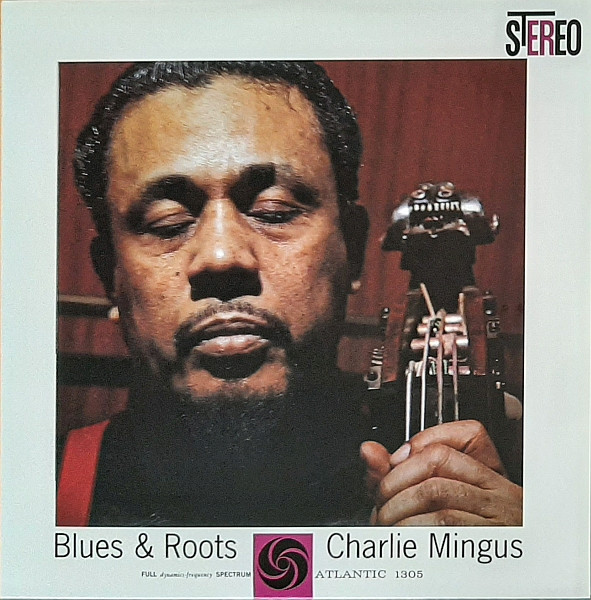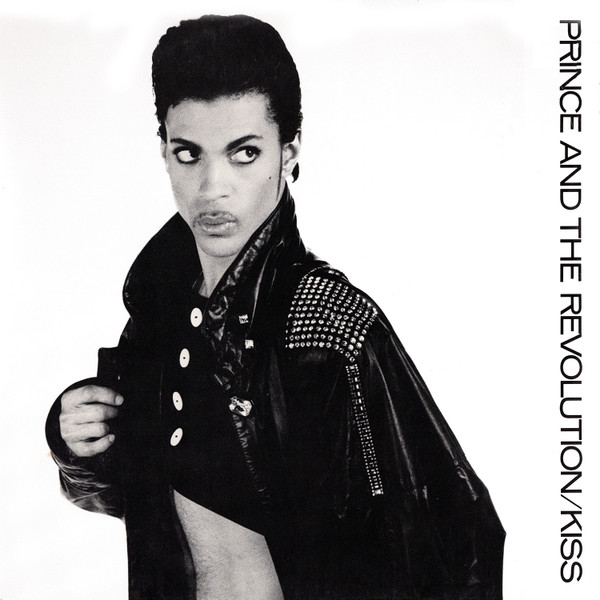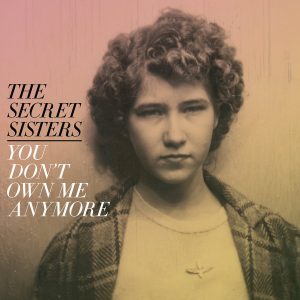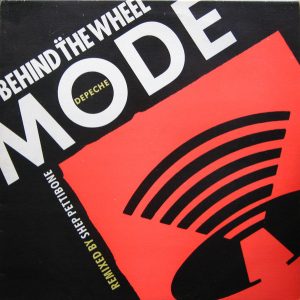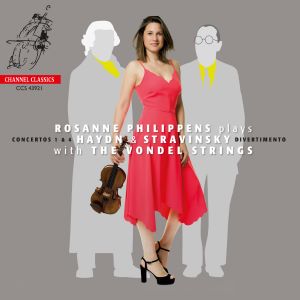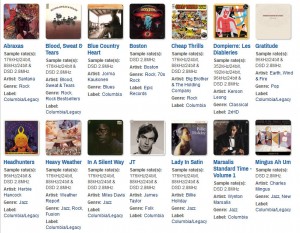Battle of the Big Bands!
This is an ongoing project by Claude Lemaire of Soundevaluations
The late-1930s to mid-1940s—it was the height of the big band era, as well as the second world war. Call me foolishly nostalgic perhaps but at least during that arduous period, we could lovingly hug and comfort each other, as opposed to now having to keep our distance for our safety and the people around us. The five selections below try to bring back that lost warmth through the music, arrangements, and sonic textures they transmit.
151. Tuxedo Junction, Tuxedo Junction. Butterfly Records – FLY 007 (1977), 33 1/3 rpm, black or gold-yellow clear colored vinyl. Genre: disco, big band swing, sweet band, latin.
"Boooard!..."
Taking its name from Glenn Miller's popular repertoire, Tuxedo Junction was a short-lived studio project produced by W. Michael Lewis & Laurin Rinder—the duo behind such disco formations as El Coco and Le Pamplemousse to mention but two. This is their self-titled debut released in January 1978. After a short intro spent at the train station, the "Chattanooga Choo Choo" departs with a thrusting pulse led by the punchy four-on-the-floor pounding away at just over 130 BPM of force. The piano is the powerful engine driving the main rhythm riff, with the brass blaring and building to a crescendo up until the vocal quartet of Jamie Edlin, Marilyn Jackson, Marti McCall, and Sue Allen chime in unison the well known lyrics. Near the end of the journey the train seems to jump over the tracks or segues rather clumsily onto "Rainy Night in Rio", and ditto into Miller's "Moonlight Serenade" which ends the first side. The flip side maintains the same high level of musicality, sophistication, and sound quality right up to the final slow track—Duke Ellington's excellent composition, "I Didn't Know About You." Recorded at Producers Workshop in Hollywood, California, engineer Joe Bellamy did a superb job capturing and remixing the band. The tonal balance is nearly spot on with a strong articulate kick drum accompanied by rich-sounding horns, and just the right amount of top end detail to keep things sharp; the only minor quibble being the upper mids feeling a fraction forward in the mix that on some systems could bother some listeners. Allen Zentz cut the lacquer at his mastering suite in California. I based my sonic impressions on my first press gold-yellow clear vinyl but did not compare it with the regular black pressing which could slightly alter in sound.
152. Tuxedo Junction, "Moonlight Serenade"/"Rainy Night in Rio." Century Records – CRDD-1140 (1978), 12", 45 rpm. Genre: big band swing, sweet band, Latin, disco. (Direct Disc Phase II) D2D lacquer cutting.
Both sides of this twelve-inch single comprise songs found on their self-titled debut LP discussed previously but presented in a slightly different interpretation, and cut direct-to-disc at 45 rpm for maximum dynamics, rise time, and clarity. Though pretty close in performance, these versions are a bit more exciting in pace and superior in sound with unsurprisingly greater dynamics, punch, and even tonal balance. In fact the latter is perfect with no signs of the mild upper mid forwardness noted above. Glen Glancy directed the recording at Capitol Records, Studio B in Hollywood, California while engineers Galen Senogles mixed it with Bill Lightner supervising the direct-to-disc mastering and cutting. Highly recommended demo-worthy.
153. The Glenn Miller Orchestra, The Direct Disc Sound of The Glenn Miller Orchestra. The Great American Gramophone Company – GADD-1020 (1977), 33 1/3 rpm. Genre: big band swing, sweet band. Direct-to-disc lacquer cutting.
When the name Glenn Miller comes up, there is a good chance that the word big band soon follows rather than jazz. Whether you consider big band music a genre in and of itself or simply one of several steps or links along the rich vast path of jazz history, certainly swing is the common denominator. Basie had it in spades and Benny was crowned the King, but Miller's orchestra occupied that middle ground between "In the Mood's" repetitive swing style precursing jump blues and early rock and roll, and "Moonlight Serenade's sweet band's smooth arrangements. Tragically, his life was cut short at age forty as his airplane disappeared in bad weather during the war. Fortunately for fans of his, from 1956 onwards the Glenn Miller Orchestra continued the late Trombonist' tradition of recording and playing for audiences. In August 1977, its eighteen musicians entered Capitol Record's legendary studio A in Hollywood California to cut a direct-to-disc master for The Great American Gramophone Company label. Ten tracks including five of their biggest hits are featured in absolutely stunning sound like the band has never been captured before. Directed by trombonist Jimmy Henderson and produced by Glen Glancy, engineers Hugh Davies and Wally Heider nailed it from start to finish. As expected from this purist recording approach harking back to the days of cutting to wax—like was the norm during the original Miller band—the dynamics and purity of tone and timbre are through the roof and to die for. No matter how great magnetic tape can be for recording—and it can be astoundingly good given the numerous fantastic-sounding albums out there—it remains there is always a certain amount of alteration to the real thing especially in transient speed and focus that D2D cutting seems to not suffer as much. But what really sets it apart from the similar and better known Harry James D2D recordings done for Sheffield Lab circa the same period, is the grainless sweetness of the brass and cymbals, making for a fatigue-free nostalgic ride of highest demo caliber, rivalled only by the 1978 M&K D2D Duke Ellington's tribute by Bill Berry and His Ellington All-Stars [RT-101] described in selection 106 (HERE).
154. Les Brown and His Band of Renown, Goes Direct to Disc. The Great American Gramophone Company – GADD-1010 (1977), 33 1/3 rpm. Genre: big band swing, sweet band, disco. Direct-to-disc lacquer cutting.
Barely two weeks after discovering the Glenn Miller selection above, I fell upon this other D2D release sharing the same label and year date in the same record store, also in mint condition for under ten bucks. Once again produced by Century Record Company's president Glen Glancy, and engineered by Hugh Davies and Wally Heider, it was cut by Bill Lightner, Bill Smith, Bill Tennis, Dave Ellsworth, Eugene Thompson, and Ken Perry. Brown's Band of Renown, which reaches back to 1938—coinciding with Miller's first single release—regroups twenty-five musicians for this date, interpreting a mixture of jazz standards plus a couple of mid-1970s pop covers such as Stevie Wonder's "Sir Duke" and Bill Conti's Theme from Rocky, "Gonna Fly Now." The sound is on par with the previous entry while the music is somewhat less captivating due to the high reliance on covers, it nevertheless is pleasant enough to have in a collection at such a low price on the second hand market.
155. Count Basie..., Chairman of the Board. Roulette – SR 52032 Birdland Series (1959), Classic Records – SR 52032 (1998?) 33 1/3 rpm, 180g Quiex SV. Genre: jazz, big band swing, Kansas City style.
Don't be confused by the title, this is not a Sinatra album nor is the Chairman joining the Count on this occasion—though both gentlemen wonderfully worked together at the Sands on the Vegas Strip, and paired for a few recordings. This is pure Basie accompanied by his orchestra of sixteen musicians including trumpeter Thad Jones, trombonist Benny Powell, and guitarist Freddie Green. Produced by Terry Reig, the ten tracks were superbly recorded at Universal Studios, Chicago in March, and Capital Studios, New York in April and December 1958. Unfortunately the recording engineer is left uncredited. Typical of Roulette of that era, and similar to Riverside recordings, the soundstage's spread and depth is spectacular and cinemascope in presentation with the brass exchanging voices forwardly between left and right extremes, and the drums, bass, and Basie anchoring centrally far back, throwing a triangular-like soundfield. Being Basie, the piano playing is sparse and never dominates, preferring to share rather than steal the spotlight with his fellow musicians. It goes without saying that these sessions swing, and true to form, blues is never far behind, characteristic of Kansas City jazz with not a dull moment to spare. I don't have an original Roulette release but Bernie Grundman's remastering and cutting for Classic Records is impressive in scale and pretty spot on in tonal balance, very wide bandwidth, crisp brass and trombone blat, clean distinct measured piano timbre, agile bass presence with natural weight, and tight percussive drums, making it one of his top big band jazz remasterings. There is more room reverberation than on a Roy DuNann engineered Contemporary but it is not over the top like some recordings of that same era, so we still can enjoy the great instrument precision. My version is the first very quiet background 180g Quiex SV pressed by RTI that Classic released and not the later 200g Quiex SV-P which may slightly differ in sound.
For more from Claude Lemaire go to his blog...
http://soundevaluations.blogspot.ca/




